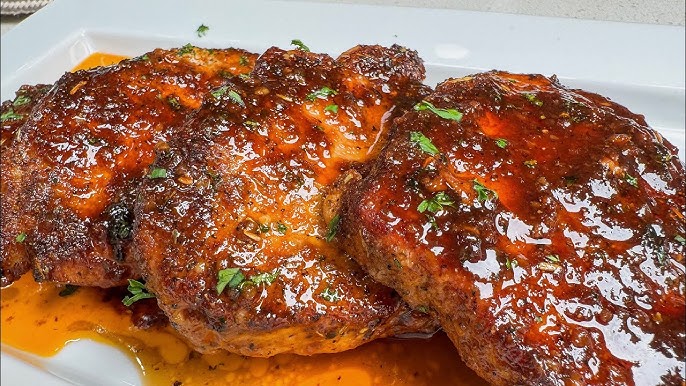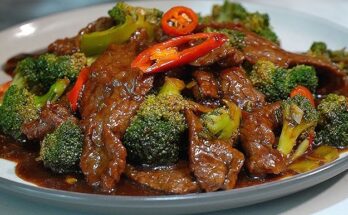Boneless Pork Chops Recipe: If you’ve ever found yourself staring blankly at a pack of boneless pork chops, unsure of how to transform them into something juicy and delicious, you’re not alone. Boneless pork chops can be tricky—they tend to dry out quickly if you’re not careful. But the good news? With the right method and a bit of know-how, you can turn this humble cut of meat into a dinner that’s bursting with flavor and perfectly tender.
Boneless pork chops are a versatile dinner hero. They’re lean, affordable, and quick to cook. Whether you’re preparing a weeknight meal for your family or impressing guests at a dinner party, this recipe offers a reliable, tasty solution. Best of all, you don’t need any fancy ingredients or culinary skills to pull this off—just follow this step-by-step guide.
In this article, I’ll walk you through everything you need to know: choosing the best pork chops, prepping them for maximum flavor, and cooking them perfectly every single time. Let’s get started!
Ingredients You’ll Need
Let’s kick things off with the basics. Here’s what you’ll need for a simple, flavorful boneless pork chops recipe:
Essential Ingredients:
- 4 boneless pork chops (about 1 inch thick)
- 2 tablespoons olive oil
- 1 teaspoon salt
- ½ teaspoon black pepper
- 1 teaspoon garlic powder
- 1 teaspoon onion powder
- 1 teaspoon smoked paprika
- 1 tablespoon fresh or dried rosemary (optional)
- 1 tablespoon butter (for finishing)
- 2 cloves garlic, minced
Optional Add-ons for Extra Flavor:
- A splash of lemon juice or apple cider vinegar (to brighten the flavor)
- 1 teaspoon Dijon mustard (for tang)
- Red pepper flakes (if you like a bit of heat)
- A few sprigs of fresh thyme (for garnish)
These ingredients create a beautiful flavor base—garlicky, slightly smoky, and rich—without being overwhelming. Feel free to tweak the seasoning blend to suit your taste buds. Want something a bit spicy? Add cayenne. More herbal? Toss in some thyme or sage.
The beauty of boneless pork chops is how well they absorb flavor. Whether you’re marinating, dry-rubbing, or pan-searing, this cut is a blank canvas just waiting for your culinary creativity.
Tools and Equipment Required
Before diving into the cooking process, it’s important to make sure you have the right tools on hand. Good equipment can make a world of difference in achieving that golden crust and juicy interior.
Must-Have Tools:
- Large skillet or frying pan (preferably cast iron or stainless steel)
- Tongs (for easy flipping)
- Meat thermometer (a game-changer for perfectly cooked pork)
- Cutting board
- Sharp knife
- Paper towels (for patting the pork dry)
- Small mixing bowl (for spices)
- Aluminum foil (for resting the meat after cooking)
Optional Tools:
- Meat mallet (if you need to even out the thickness)
- Oven-safe skillet or baking sheet (if you finish the chops in the oven)
- Basting brush (for brushing with butter or marinade)
A heavy-bottomed skillet, especially cast iron, is ideal for searing pork chops because it retains and distributes heat evenly. That helps create a beautiful crust without burning the exterior.
Don’t underestimate the power of a meat thermometer either—it ensures you don’t overcook and dry out the pork. Aim for an internal temp of 145°F (63°C) for the perfect balance of safety and succulence.
Choosing the Best Boneless Pork Chops
Not all pork chops are created equal. Choosing the right cut is crucial if you want tender, juicy results.
What to Look For:
- Thickness: Aim for chops that are at least ¾ to 1 inch thick. Thinner chops cook faster but are more likely to dry out.
- Color: Fresh pork should be light pink with some marbling (white streaks of fat). Avoid chops that look gray or have excess liquid in the package.
- Fat Cap: A small strip of fat on one edge is fine and can enhance flavor. Trim off excess, but don’t remove it entirely.
Types of Boneless Pork Chops:
- Loin chops: These are lean and tender, ideal for quick cooking.
- Rib chops: Slightly more marbled, offering better flavor and juiciness.
If you can, buy your pork chops from a butcher. You’ll often get fresher meat and can request specific thicknesses. Pre-packaged pork from the grocery store works too—just be selective.
Prepping the Pork Chops
Prep work is where the magic begins. Don’t skip this step—it’s your secret weapon for flavor and moisture.
1. Trim and Clean:
Start by patting the pork chops dry with paper towels. This helps the seasoning stick and ensures you get a good sear. If there’s excess fat, trim it off, but leave a thin layer for flavor.
2. Brine for Juiciness (Optional but Recommended):
Brining pork chops for 30 minutes to 2 hours can make a world of difference.
Simple Brine Recipe:
- 4 cups water
- ¼ cup kosher salt
- 2 tablespoons sugar (optional)
Dissolve the salt and sugar in water, then submerge the chops. After brining, rinse them briefly and pat dry. This process infuses moisture and seasoning deep into the meat, helping prevent dryness during cooking.
3. Season Generously:
Combine your dry spices in a bowl, then rub them all over each pork chop. Make sure every inch is coated. Let the seasoned chops rest at room temperature for 15–20 minutes before cooking—this helps them cook more evenly.
Cooking Methods: Pan-Seared to Perfection
Now that your pork chops are prepped and ready, let’s get to the fun part—cooking! One of the best and most popular ways to cook boneless pork chops is pan-searing. It’s quick, simple, and delivers a crispy, golden-brown crust with a juicy interior.
Step-by-Step Pan-Searing Instructions:
- Preheat the skillet: Place your skillet over medium-high heat and let it get nice and hot. You want to hear that satisfying sizzle when the pork hits the pan.
- Add oil: Pour in the olive oil and swirl to coat the pan.
- Sear the chops: Place the pork chops in the skillet without crowding them. Sear for 3-4 minutes on one side without moving them to develop a golden crust.
- Flip and finish: Turn the chops over and sear the other side for another 3-4 minutes.
- Butter baste (optional but amazing): Add the butter and minced garlic to the pan. Tilt the skillet slightly and use a spoon to baste the hot, garlicky butter over the chops for a minute or two.
- Check internal temp: Use a meat thermometer to check for doneness. You’re aiming for 145°F (63°C).
- Rest: Transfer the chops to a plate and cover loosely with foil. Let them rest for 5-10 minutes before serving.
Alternative Methods:
- Baking: Preheat oven to 400°F. Sear chops in a pan first, then transfer to the oven for 6–8 minutes.
- Grilling: Great for summer! Preheat grill to medium-high, grill each side for 4–5 minutes.
- Sous-vide: A foolproof but time-consuming method. Cook at 140°F for 1-2 hours, then sear.
Each method has its perks, but pan-searing is the most straightforward and yields restaurant-quality results with minimal fuss.
Checking for Doneness
Overcooked pork chops are the fastest way to ruin dinner. But undercooked pork? Also a no-go. Here’s how to hit that sweet spot.
How to Know Your Pork Is Perfectly Cooked:
- Use a thermometer: This is your most reliable tool. Insert it into the thickest part of the chop.
- 145°F (63°C) = Perfectly cooked, slightly pink in the center
- 160°F (71°C) = Well done (may be slightly dry)
- Touch test: Press the center of the pork chop. It should feel firm but not hard—similar to pressing the fleshy part of your thumb.
Don’t Forget the Resting Time:
After cooking, let the chops rest for 5–10 minutes. This step allows the juices to redistribute throughout the meat instead of spilling out when you cut into it. Trust me, it’s worth the wait!
Serving Suggestions and Side Dishes
Now let’s talk about what to serve with your juicy boneless pork chops. The right sides can elevate this dish from a simple dinner to a show-stopping meal.
Starch Pairings:
- Mashed potatoes: Creamy and comforting
- Roasted sweet potatoes: Adds a sweet contrast
- Garlic butter rice: Simple but flavorful
Vegetable Options:
- Roasted Brussels sprouts or broccoli
- Sautéed green beans with garlic
- Mixed greens with vinaigrette
Sauce Ideas:
- Pan sauce: Deglaze the skillet with chicken broth, add a splash of cream and mustard
- Apple chutney: Sweet and tangy, complements pork beautifully
- Mushroom gravy: Earthy and rich, perfect for cooler months
Serving tip: Slice your pork chops and fan them out on the plate with your chosen sides and drizzle any remaining pan juices over the top for added flavor and visual appeal.
Storing and Reheating Leftovers
Made more than you could eat? No worries! Boneless pork chops store and reheat beautifully with the right approach.
Storage Tips:
- Let the pork chops cool completely before storing.
- Place in an airtight container or wrap tightly in foil.
- Store in the refrigerator for up to 3-4 days.
Reheating Without Drying Out:
- Oven method: Preheat to 300°F, place chops in a baking dish with a splash of broth or water, cover with foil, and heat for 10–15 minutes.
- Skillet method: Heat on low with a little butter and cover to trap moisture.
- Microwave: Use a microwave-safe plate, cover with a damp paper towel, and heat in 30-second intervals.
Avoid high heat when reheating, as it can dry out the meat. Adding a bit of liquid (broth, water, or even butter) helps maintain juiciness.
Tips for Extra Flavor
Want to make your boneless pork chops next-level delicious? Here are a few pro tips to pack in even more flavor.
Marinate for a Flavor Boost:
If you’ve got extra time, marinate your pork chops for a few hours or overnight.
Easy Marinade Recipe:
- ¼ cup olive oil
- 2 tablespoons soy sauce
- 1 tablespoon Dijon mustard
- 1 tablespoon honey
- 1 garlic clove, minced
Add a Crust or Coating:
Try dredging the chops in seasoned flour or panko breadcrumbs before pan-searing for a crispy texture.
Layer Flavors:
- Fresh herbs: Sprinkle with chopped parsley, rosemary, or thyme before serving.
- Acid: Finish with a squeeze of lemon juice or a splash of vinegar to brighten everything up.
- Glaze: Brush with a maple or balsamic glaze for a sweet and savory combo.
These small touches don’t take much time but add a huge flavor impact.
Common Mistakes to Avoid
Even seasoned home cooks can run into trouble with boneless pork chops. Here are some of the most common mistakes—and how to avoid them—so your dinner always hits the mark.
1. Overcooking the Pork
This is the number one reason pork chops turn out dry and tough. Remember, pork only needs to be cooked to 145°F (63°C), followed by a rest. Don’t play it by ear—use a thermometer and trust it.
2. Not Letting the Meat Rest
It might be tempting to cut into your pork chop immediately after cooking, but resist the urge. Resting the meat is essential for keeping it juicy. Just 5–10 minutes of patience makes a noticeable difference.
3. Skipping the Seasoning
Plain pork chops can taste bland without proper seasoning. Even a simple salt-and-pepper rub enhances the natural flavor. Want to go a step further? A spice blend or marinade works wonders.
4. Cooking Straight from the Fridge
Cold meat doesn’t cook evenly. Let your pork chops sit at room temperature for about 15–20 minutes before cooking. This ensures they cook more evenly and helps you avoid that tough outer ring.
5. Using a Cold Pan
Always preheat your pan. A hot surface is key to achieving a golden-brown crust. If the pan isn’t hot enough, the pork will steam instead of sear—and you’ll miss out on that delicious texture.
Making It a Complete Meal
A good main dish deserves good company. Let’s talk about how to make this pork chop recipe part of a balanced, satisfying meal that hits every note.
Build a Balanced Plate:
- Protein: Boneless pork chops
- Vegetable: Roasted or steamed greens
- Starch: Potatoes, rice, or quinoa
- Sauce: Gravy or pan sauce
- Fresh Element: Side salad or fruit compote
Simple Meal Ideas:
- Weeknight Dinner: Pork chops + mashed potatoes + green beans
- Fancy Dinner: Pork chops with apple glaze + roasted root vegetables + arugula salad
- Low-Carb Option: Pork chops + cauliflower mash + sautéed spinach
You can also make a pork chop sandwich or slice the meat thinly to serve over a salad or grain bowl. Leftovers become lunch magic!
Adapting the Recipe for Dietary Needs
Got food restrictions? No problem. This pork chop recipe is highly adaptable and can easily fit into various dietary lifestyles.
Gluten-Free:
- All ingredients are naturally gluten-free.
- Just make sure any store-bought sauces or spice blends don’t contain hidden gluten.
Low-Carb/Keto:
- This recipe is already low in carbs.
- Pair with cauliflower mash or a green vegetable for a keto-friendly meal.
Dairy-Free:
- Simply omit the butter or replace with a dairy-free alternative like ghee or olive oil.
Low-Sodium:
- Reduce the amount of salt in the brine or seasoning.
- Avoid salty sauces like soy sauce or opt for a low-sodium version.
Whatever your dietary needs, a simple tweak or two will help make this recipe work for you.
Variations to Try
One of the best things about boneless pork chops is their versatility. Once you’ve mastered the basic method, feel free to experiment and get creative in the kitchen.
Global Flavors:
- Italian: Use oregano, thyme, and garlic, and finish with a sprinkle of parmesan.
- Mexican: Add cumin, chili powder, and lime juice.
- Asian: Marinate in soy sauce, ginger, garlic, and a touch of honey.
Cooking Styles:
- Stuffed pork chops: Slice a pocket into the chop and stuff with cheese, spinach, or mushrooms.
- BBQ style: Slather with your favorite barbecue sauce and finish in the oven or on the grill.
- Breaded and baked: Coat in panko or breadcrumbs and bake until crispy.
Each variation offers a new flavor profile and keeps the dish exciting every time you make it.
FAQs about Boneless Pork Chops Recipe
1. Can I use bone-in pork chops instead of boneless?
Yes, you can! Just keep in mind they might take a few minutes longer to cook. Always use a thermometer to check doneness.
2. How do I keep boneless pork chops from drying out?
Brining helps, but the most important tip is not to overcook them. Cook to 145°F and let them rest.
3. Can I freeze cooked pork chops?
Absolutely. Let them cool completely, then wrap tightly and freeze for up to 3 months. Reheat gently to avoid drying them out.
4. What’s the best oil for searing pork chops?
Use oils with a high smoke point like olive oil, avocado oil, or canola oil. Avoid butter for the initial sear—it burns easily.
5. What herbs go well with pork chops?
Rosemary, thyme, sage, and parsley all pair beautifully with pork. Fresh herbs are especially flavorful.
Conclusion
Boneless pork chops might not always steal the spotlight like steak or chicken, but they deserve a place in your weekly meal rotation. With the right prep and cooking method, they can be juicy, flavorful, and downright crave-worthy. Whether you’re going for a quick weeknight meal or a dish that impresses dinner guests, this recipe is a foolproof foundation.
We covered everything you need—from choosing the best pork chops and seasoning them right to cooking them perfectly and pairing them with delicious sides. The secret to success? Don’t rush, use a thermometer, and let those chops rest.
So go ahead—grab those pork chops and turn them into something special tonight.



